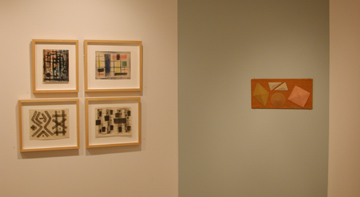




Link to photographs
of Weininger works
Click here to return
to the first Weininger page.
Link to photographs
of Weininger works
Link to introduction by
curator Oliver A.I. Botar
Link to the catalogue
of Gallery One One One's
Weininger collection


ABOVE: The Andor Weininger installation at Gallery One One One. These works are in the permanent collection of Gallery One One One, gifts of the Weininger Foundation. Photography credit: Robert Epp.
FROM BAUHAUS TO OUR HOUSE IN ETOBICOKE:
ANDOR WEININGER IN THE 50s
Andor Weininger was one of only two Bauhaus figures to have lived in Canada. Born in Hungary in 1899, he studied art and design at the Bauhaus, the famous German design school, during the early 1920s. In 1923 he co-founded the Bauhaus Jazz Band, which became well-loved for its brand of up-beat party music. In the meantime, he produced a fascinating body of work, mostly related to the stage, attaining his greatest success with his Mechanical Stage-Review, a kind of moving abstract painting, and with his design for a spherical theatre. After graduating in 1925, Weininger stayed on at Walter Gropius’ request, to act as a kind of public relations official for the school. After leaving the Bauhaus in 1928, he and his German fiancée Eva Fernbach supported themselves through Modernist furniture design. The Weiningers married in 1931, and escaped Nazi Germany for the Netherlands in 1938, where Andor produced Surrealist and Biomorphic Modernist works. The Weiningers emigrated to Canada with their daughter Cornelia in 1951.
The Weiningers settled in the lakeside Mimico district of Etobicoke, just west of Toronto, where Andor associated himself with the emergent Canadian abstract art scene, particularly with Jock Macdonald and William Ronald. Andor produced a remarkably inventive and eclectic body of work ranging from sketches of his home on the shores of Lake Ontario, through figural work in the mode of Paul Klee, to calligraphic and textured abstract works, often employing complex, layered techniques of pigment application. In these works we see the adaptation of Bauhaus principles of composition and technique, as well as the typically Bauhaus penchant for the use of colour primaries. As one can see in some of the works (and as signalled by the colours of the three corner walls of the gallery), the primaries of the early 1920s often translated into the pastels of 1950s material culture.
Despite the beauty of their surroundings in Etobicoke, and their pleasure in travelling regularly to cottage country, the Weiningers felt dissatisfied with their reception in Canada and with what they saw as the conservatism of Toronto’s cultural scene. While both Macdonald and Ronald recommended Weininger for inclusion in the important travelling "Exhibition of Abstract Painting by Canadian Artists" (1952-53), Ronald did not invite Weininger to join the crucial "Painters Eleven" group of Toronto abstract artists. This circumstance, as well as rejections from more conservative Canadian artistic organizations, served to distance Weininger from the Canadian art scene. The Weiningers also felt isolated from their Bauhaus friends and colleagues, many of whom were successful architects, artists and teachers living in the United States, while the Weiningers languished in unemployment. As Andor wrote to Casca Schlemmer in January of 1955, "Toronto continues to give me little joy, I have in the meantime again suffered more rejections of my pictures." In 1953, as soon as he was able, Andor began visiting the United States, though his attempts to sell works to or show at the Guggenheim Museum in New York and the Carnegie Institute in Pittsburgh were unsuccessful. Nevertheless, after he received Canadian citizenship in 1957, the Weiningers emigrated to the USA, joining Eva’s family in New York by the end of 1958. They lived and worked together in New York until Andor’s death in 1986. Eva, who recently celebrated her 101st birthday, lives in San Antonio, Texas.
Andor Weininger’s Canadian oeuvre is exceptional within the Canadian context for its freedom, technical inventiveness and playfulness, characteristics typical of the Bauhaus approach to art and aesthetic education. While related in some ways to the work of Painters Eleven, it is also independent of them in Weininger’s refusal to work at a large scale, and in his parallel pursuit of abstraction and figuration. Finally, it should be noted that despite his own perceptions about Toronto, Weininger had his only one-person show during his lifetime in that city, and his Canadian period was one of his most productive artistically.
The Weininger Foundation was generous enough to include in its donation works from before and after Weininger’s Canadian period. Thus, this show also includes such works. The majority of the pieces on display in this gallery are being shown for the first time.
Oliver A. I. Botar, Curator
Acknowledgements
I wish to thank the following: DIY for framing; Richard Dyck for design and production of the display cases; William Eakin for photography; Cliff Eyland for ongoing support; Thomas Ford for photography at the Houghton Library, Harvard University; Zab Hobart for graphic design; Jasmina Jovanovic-Vlaovic and Radovan Radulovic for conservation of artworks; Diane Lafournaise for cataloguing the donation; Celia Rabinovitch for identifying artistic techniques and media; Beverly Schreiber Jacoby for coordinating the donation process; and Lana Wilson for research assistance. Most of all I wish to thank Eva Weininger and Anita Younes of the Weininger Foundation for their generosity in donating these works to Gallery One One One and for financially supporting this exhibition. Finally, I wish to thank Robert Epp, without whose multifaceted participation in all stages of the Weininger project, this exhibition could not have come to fruition. Some of the research for the show has been carried out with the support of a grant from the Social Sciences and Humanities Research Council of Canada. I wish to thank the Council for its support – Oliver Botar
Gallery One One One, School of Art, Main Floor, FitzGerald Building, University of Manitoba Fort Garry campus, Winnipeg, MB, CANADA R3T 2N2 TEL:204 474-9322 FAX:474-7605 For information please contact Robert Epp
eppr@ms.umanitoba.ca
|
|

